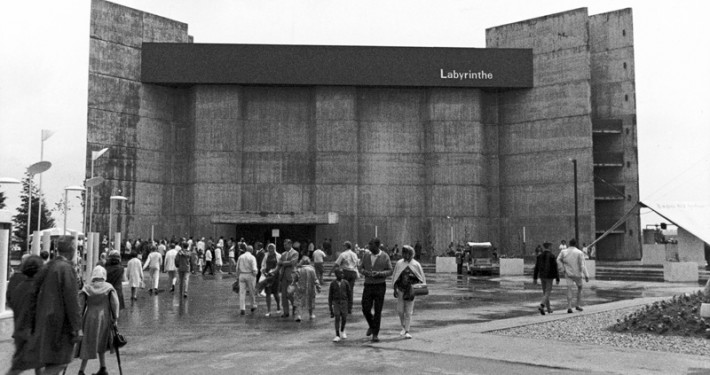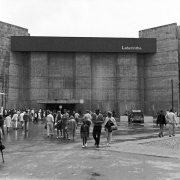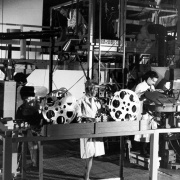Labyrinth/Labyrinthe was produced by the National Film Board of Canada under the direction of filmmakers Roman Kroitor and Colin Low. It was commissioned as part of Expo 67’s theme, Man the Hero, and designed around the myth of the Minotaur. The pavilion contained three chambers, the first and third of which were film-screening venues. In the first chamber, audiences stood in four stacked rows of elliptically shaped balconies to watch a huge two-screen film. The work was projected on two fifty-foot (fifteen-metre) screens, one placed horizontally along the floor and the other vertically at the far end of the chamber. The shot sequences in the two separate films were edited so as to provide reflective images of a loosely structured universal life story – for instance, the image of a baby on the floor screen, with a father, looking down at the baby, projected onto the wall screen. Between the two chambers, the audience moved through a labyrinth-like passage constructed of two-way mirrors through which they could see thousands of small lights.
Emerging from that labyrinth, the audience was ushered into a conventional auditorium. In this third chamber they were shown a film projected on five screens arranged in a cruciform. The film, co-directed by Roman Kroitor, Colin Low, and Hugh O’Connor and edited by Tom Daly, used a variety of images shot in various global locations (including the African jungle, the GUM department store in Moscow, the funeral of Winston Churchill in London) to elicit the idea of trial and triumph. This second work, under the title In the Labyrinth, remains an enduring masterpiece of multiscreen cinema and continues to be available as a single screen film from the National Film Board. The separate images were integrated into a single strand of film, using a “five-on-one” cinematic technique. Watch it on the National Film Board site here.
Colin Low
Colin Low is associated with the National Film Board of Canada and the renowned Unit B, where he made many famous animated and cinèma-veritè films and pioneered the Challenge for Change (1967) program. He consulted and worked on the animation for the first anaglyph, single-projector 3D film, We Are Born of Stars (1985), for IMAX. He then went on to direct the first IMAX 3D production. He was named a member of the Order of Canada in 1996. In 1997, he received the Prix Albert-Tessier and received a lifetime achievement award by the Large Format Cinema Association in 2002. His contribution to film has been recognized with several honorary degrees, and numerous awards.
Roman Kroitor (d. 2012)
Roman Kroitor joined the National Film Board as a summer intern in 1949. As one of the leading members of the cinéma-vérité movement at the NFB’s Unit B, Kroitor made a major contribution to the influential Candid Eye series. He left the NFB in the late 1960s to found the IMAX Corporation with Graeme Ferguson and Robert Kerr, and returned in the mid 1970s and put in charge of dramatic production. He was one of several directors of the first feature-length and first concert film shot in the IMAX format, Rolling Stones at the Max in 1991. He invented the Sandde hand-drawn stereoscopic animation system. He is the recipient of numerous awards.






